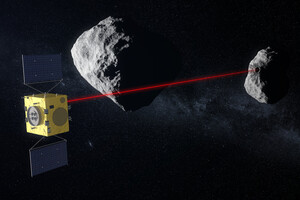Scientists believe that this could completely destroy Dimorph.

New mission simulation Double Asteroid Redirection Test (DART) , which is to collide with an asteroid satellite, showed that the consequences of such an impact will not be as expected. Instead of leaving a small crater, the device will completely destroy the celestial body, according to Space.com.
Read also: A fragment of the asteroid that destroyed the dinosaurs – CNN
DART is an ambitious mission to test the effectiveness of using a “kinetic impact element” to deflect an asteroid heading for Earth. In this case, the “kinetic impact element” is a spacecraft that travels to a celestial body.
DART is expected to collide with the asteroid's satellite Didim Dimorph at a speed of about 23,760 kilometers per hour. This, scientists believe, should change the orbital speed of the asteroid's satellite by a fraction of a millimeter per second, which is enough to change its orbit around the mother's body. Although Didim and Dimorph do not pose a threat to the Earth, they are an ideal model for testing the concept of using a kinetic element. If it proves viable, NASA will have the option of protecting the planet from a possible collision with an asteroid.
In a new simulation conducted by scientists from the University of Bern and the National Center for Competence in Planetary Research, scientists used a new approach that took into account waves and the process of crater formation that follow the DART impact. This simulation also took into account the fact that Dimorph may not have a monolithic, but a looser, fragmented nucleus.
As a result, scientists have found that the collision could knock more material out of Dimorph than expected and change its course more dramatically than previously thought.
Contrary to what can be imagined by depicting an asteroid, direct data from space missions, such as the Japanese space agency's Hayabusa-2 probe, show that the asteroid may have a very loose internal structure – like a pile of rubble – held together by gravity and small clutch forces. This could drastically change the outcome of the DART-Dimorph collision, “said study lead author Sabina Radukan, a researcher at the University of Bern.
In September 2022, DART is to crash into Dimorph. This will be the first demonstration of the agency's strategy to protect the Earth from asteroids.
The spacecraft will crash into the asteroid's satellite to change its trajectory. The impact is expected to change Dimorph's rotational speed around Didim by only 1%. This, in turn, will change the orbital period of the object by a few minutes, which can be seen with ground-based telescopes.
The collision will be humanity's first attempt to change the dynamics of celestial bodies in the solar system.
Double the system was opened in 1996. It consists of two celestial bodies: Didymus with a diameter of about 780 meters and Dimorph, whose diameter is estimated at 160 meters. In September 2022, the system will come relatively close to Earth and will be at a distance of 11 million kilometers from it.




